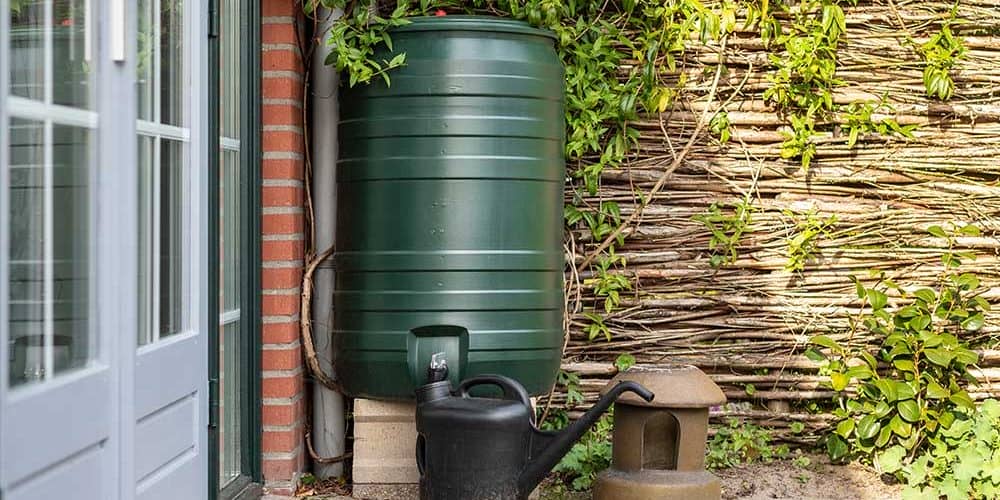If you are wondering how to have flourishing garden borders and green, healthy grass whilst keeping water usage to a minimum, you may want to consider rainwater harvesting. Here are our six reasons why it’s worth investing time in this approach for your everyday water needs.
Rainwater harvesting is the process of collecting and storing rainwater that falls on rooftops, paved surfaces, or any other catchment area. The collected rainwater can be used for various purposes, such as watering plants, flushing toilets, doing laundry, or even as a source of drinking water after proper filtration and treatment. There are several reasons why rainwater harvesting can be a better option than relying on an outside water tap:
- Conservation of water
Harvesting rainwater is a sustainable and environmentally friendly practice. It helps to conserve water by utilising rainwater that could otherwise go to waste or contribute to stormwater runoff. It reduces the demand for water from traditional sources such as rivers, lakes, and underground aquifers, which can be strained due to population growth and climate change.
- Cost savings
By collecting rainwater and using it for non-potable purposes, you can reduce your reliance on the municipal water supply. This can result in lower water bills and cost savings in the long run, especially in areas where water prices are high.
- Sustainable water management
Rainwater harvesting is an eco-friendly practice that promotes sustainable water management. It reduces the demand for treated water, which requires energy-intensive processes such as purification and distribution. By using rainwater, you contribute to a more sustainable and efficient water cycle.
- Decreased strain on drainage systems
Heavy rainfall can sometimes overwhelm stormwater drainage systems, leading to flooding and damage. By harvesting rainwater, you can reduce the amount of runoff, lessening the burden on drainage infrastructure and mitigating the risk of local flooding.
- Improved plant health
Rainwater is generally better for plants than chemically treated tap water. It lacks the salts, minerals, and chemicals commonly found in tap water, which can actually be harmful to some plants. Using harvested rainwater for irrigation can promote healthier growth and reduce the need for synthetic fertilisers.
- Self-sufficiency
Rainwater harvesting provides a degree of self-sufficiency for your water supply, particularly in areas where water scarcity or restrictions are a concern. Having a stored supply of rainwater gives you a backup source for various domestic uses, even during water shortages or drought conditions.
How does a rainwater harvesting system work?
A rainwater harvesting system typically consists of several components that work together to collect, store, and distribute rainwater. The specific design may vary depending on the scale and purpose of the system, but here is a general overview of how a rainwater harvesting system works:
- Catchment surface:
The catchment surface is usually the roof of a building, which collects rainwater as it falls. The roof material should be suitable for rainwater harvesting, such as metal, tile, or concrete, to ensure the water quality remains high.
- Gutters and downspouts
Gutters are installed along the edges of the roof to collect rainwater and channel it towards the downspouts. The downspouts direct the water from the roof to the storage tanks or other storage containers.
- Filtration
Before the rainwater enters the storage tanks, it needs to be filtered to remove debris, leaves, and other contaminants. This can be done using a mesh or screen filter installed at the entry point of the downspouts or a separate first-flush diverter system that diverts the initial dirty runoff.
- Storage tanks
The filtered rainwater is directed into storage tanks or cisterns. These tanks can be above-ground or underground, made of materials such as plastic, concrete, or fibreglass. The size of the tanks depends on the amount of rainfall in the area and the intended use of the harvested water.
- Overflow and drainage
When the storage tanks reach their capacity, excess rainwater needs to be safely drained to avoid flooding. An overflow pipe or a diversion system is installed to direct the overflow away from buildings or into a separate drainage system.
- Pump and distribution
When you need to use the harvested rainwater, a pump can be installed to pressurise the water for distribution. The pump can be connected to an outside tap or a plumbing system to supply the water to different areas of the building for various purposes such as irrigation, toilet flushing, or laundry.
- Treatment (optional)
Depending on the intended use of the harvested rainwater, additional treatment may be necessary. This can include disinfection through filtration, UV treatment, or chemical treatment to ensure the water is safe for drinking or other potable uses.
It's important to note that rainwater harvesting systems should be designed and installed by professionals to ensure efficiency, water quality, and compliance with local regulations. Regular maintenance, such as cleaning filters, inspecting storage tanks, and checking for any leaks, is also essential to keep the system functioning optimally.
Find out how to set up a rainwater harvesting system in your garden here. Don’t forget, if you need some help, our team of experienced plumbers are always at hand to ensure there are proper connections between downspouts, storage tanks, and distribution points.

